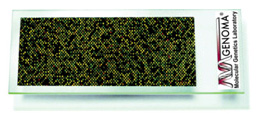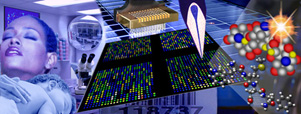New and revolutionary 24 chromosomes aneuploidy screening by array-CGH aims to improve IVF clinical pregnancy and live birth rates
 Preimplantation Genetic Screening (PGS)
Preimplantation Genetic Screening (PGS)
Numerical chromosomal abnormalities are presumed to be a major factor in causing low pregnancy rates and high miscarriage rates in assisted reproduction. Preimplantation genetic screening (PGS) aims to provide a means of identifying potentially viable euploid embryos for transfer.
Prior PGS strategies have mainly involved analysis of a single cell followed by fluorescence in situ hybridization (FISH) using probes for a limited number of chromosomes (5-9 chromosomes).
Different studies have shown that PGS, as it is currently practiced, does not improve live birth rates in patients of advanced maternal age, with recurrent implantation failure or repeated pregnancy loss. It has been argued that an inadequate cytogenetic method, as FISH, which screens for a minority of chromosomes, may have led to a reduced diagnostic accuracy, eliminating any potential benefit of screening.
Recently, a 24 chromosomes PGS by Array Comparative Genome Hybridization (Array-CGH) has been proposed in order overcome the technical difficulties that beset earlier PGS studies, which examines the entire chromosome complement from the biopsied cells, rather than the limited chromosome assessment.
 Full Chromosome Analysis by ARRAY CGH
Full Chromosome Analysis by ARRAY CGH
Internationally, most groups have now moved over to new technology
array comparative genomic hybridisation (array-CGH).
In an effort to provide you with the best testing and service available, we would like to inform you that Array-CGH is now available to offer to patients pursing preimplantation genetic screening (PGS). Array CGH allows GENOMA to screen all chromosomes in 24-30 hours of sample receipt.
The array has many probes for each chromosome and enables simultaneous screening of many locations on each chromosome. Array CGH also detects all mitotic and meiotic abnormalities present in one cell or tissue sample. Unlike SNP arrays, Array-CGH does not require testing of the couple or the couple’s parents prior to the IVF cycle. In addition, there are no set up fees associated with Array-CGH.
Array CGH technique can be used no only to test for chromosomal aneuploidy, but also for translocations, inversions and other chromosomal abnormalities—both gains and losses.
Using state-of-the-art genome arrays, robust experimental protocols in comparative genomic hybridization, reagents and patented software, GENOMA produces the highest levels of reproducibility and sensitivity. The data are clear, crisp and reliable, and genetic experts provide you with unambiguous interpretation of the results.
Chromosome analysis (PGS) can be performed alone or in combination with single gene mutation (PGD) on the same sample. For PGD/PGS cases parental cheek brush swabs are requested in order for our scientists to build personalized genetic probes customized to the patient’s mutation. Once these probes are designed, the patient will be approved for both tests.
Our Experience – Clinical Results and Ongoing Validations
To date we have completed more than 100 procedures of Array-CGH. The frequency of single cells producing no results is 2%.
GENOMA routinely reanalyzes embryos that are not replaced for continual validation and assessment of technical error rates. We utilize Fluorescent PCR for reanalysis to ensure that the potential shortcomings of Array-CGH would be detected by a different technique.
Day 3 Blastomere or Day 5 Trophectoderm Biopsy and Sample Preparation

Array CGH can be applied to
polar bodies (1PB+2PB), a single cell from a day 3 embryo or trophectoderm tissue from day 5 or day 6 blastocysts.
Some patients prefer not to delay embryo transfers to accommodate analysis on trophectoderm tissue. Array-CGH results are available for a fresh day 5 replacement when performing a biopsy on polar bodies or Day 3 embryos. In all cases, we recommend that only replacement quality embryos are slated for biopsy. The biopsy of poor quality embryos will increase the cost of the test and likely not provide results, as the quality of DNA will typically not amplify properly.
Several recent studies support analysis on day 5 or 6 trophectoderm tissue for patients that are willing to cryopreserve embryos and delay the embryo transfer. Based on these studies, there may be advantages of trophectoderm biopsy for some cases, showing that the best embryos develop to blastocysts and that blastocyst transfer can give improved pregnancy rates for certain groups of patients. Even though trophectoderm biopsy presently requires cryopreservation, our experience is that more than 99% of embryos survive the trophectoderm biopsy and vitrification process. . It is also believed that transferring the blastocysts in a future cycle, rather than in the cycle they were collected in, may further increase pregnancy rates as this allows the womb to be prepared for implantation.
The single cell or tissue sample from each embryo is loaded into PCR tubes; this is similar to sample preparation for molecular testing methods used in single gene disorder PGD. While the quality of the results are technician dependent, some embryologists find it easier to load PCR tubes than perform the cell fixation required for PGS utilizing FISH. If your embryology staff needs assistance or training we can provide this service. When needed, an experienced embryologist can be sent to your center to perform polar body, Day 3, or trophectoderm biopsy and/or sample preparation. In addition we can provide biopsy and cell preparation training.
Abnormalities Ascertainment
Aneuploidy: Our current estimate, based on our validation experiments, is that Array-CGH will detect approximately 50% more abnormalities than 12 probe FISH and 20% more abnormal embryos (abnormalities tend to concentrate on the same embryos). Being quantitative, Array-CGH can detect all aneuploidies. In contrast, some SNP approaches relying on qualitative assessment of aneuploidy may miss trisomies of mitotic origin or originating from meiosis II aneuploidy without crossing---over.
Polyploidy: Array-CGH cannot detect polyploidy, but this would result in only 0.2% missed abnormalities.
Structural abnormalities: Array CGH can detect deletions and duplications of small pieces of DNA. Presently, we are using Array-CGH not only to detect whole chromosome numerical abnormalities (aneuploidy) but also for translocations, inversions and other chromosomal abnormalities.
Important Note: Test can be ordered on the same day of the biopsy since there is no need to analyze the DNA of the parents beforehand. Please make sure to review all protocols and have an orientation with our team prior to your first case.